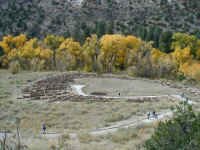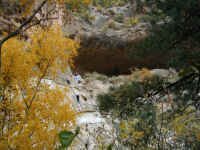10/21
After spending the night in the campground at Bandelier National Monument, we started our day with a visit to the visitors center and then a hike into Frijoles Canyon.
The ruins in Bandelier are different from anything else we have seen so far because the geology of the area is different. Over a million years ago, two eruptions of the Jemez Volcano ejected enough rock and ash to cover a four-hundred-square mile area with 1,000 feet of material.
Today, the canyon walls are made up of volcanic rock and compressed volcanic ash called "tuff". Weathering of the softer areas of the cliffs created the "swiss cheese" appearance of the cliffs. The Ancient Puebloans who lived here used the rock for walls, but they also carved into the soft tuff and enlarged the naturally occurring caves, probably using them as storage areas.
| In Frijoles Canyon, there are several different dwelling areas. The first, a pueblo called Tyuonyi was built on the canyon floor about 600 years ago. It was two stories high and housed about 100 people. |
Up at the base of the canyon wall was a multiple-room cliff dwelling called "Talus Houses" because it was built from the rocks that fell from the canyon walls (this is called talus). These structures were built up against the cliff face and utilized the natural caves. These homes could be three or four stories high.
Further down the canyon is "Long House". This was a series of dwellings that stretched 800 feet down the canyon wall. All along the wall where the roofs would have been were holes carved into the canyon wall that would have held the roof supports. Above these were many petroglyphs. On what would have been inside walls, there were areas where you could still see painted designs on the plaster. It was really beautiful.
| The most exciting part of our visit was the exploration of a cave that housed a reconstructed kiva. Not the the cave was anything special, but the climb up 140 feet of ladders was very exciting! |
After a picnic lunch in the canyon, we continued through Bandelier along highway 4. We passed through areas that had been burned in a forest fire in 1997. Natural fires had not been allowed to burn due to a policy of fire suppression and so a lot of underbrush had accumulated. Subsequently the fire burned very hot and did a lot of damage to the archaeological sites in the park and burned a lot of trees. Even four years later the area looked pretty sad.
Further south, highway 4 parallels the Jemez River. The cottonwood trees lining the river were turning colors and the golden glow from them was unbelievable.
We spent the night alongside the river and let its gurgling lull us to sleep.

